Research Methodology: Technology Impact on Hospitality Satisfaction
VerifiedAdded on 2021/04/24
|10
|2121
|59
Report
AI Summary
This report investigates the impact of technology on customer satisfaction within the hospitality industry, employing a qualitative research methodology. The study utilizes an unstructured interview with a hotel supervisor to gather primary data regarding their perceptions on the role of technology in shaping customer experiences. The analysis, conducted through open and axial coding techniques, reveals insights into the technological amenities, their perceived importance to guests, and their influence on customer decisions. Ethical considerations were maintained by ensuring the anonymity of the interviewee. While acknowledging limitations due to the small sample size, the report concludes that technological advancements significantly influence customer expectations and satisfaction, highlighting the importance of continued investment and development in this area to enhance the hospitality industry.
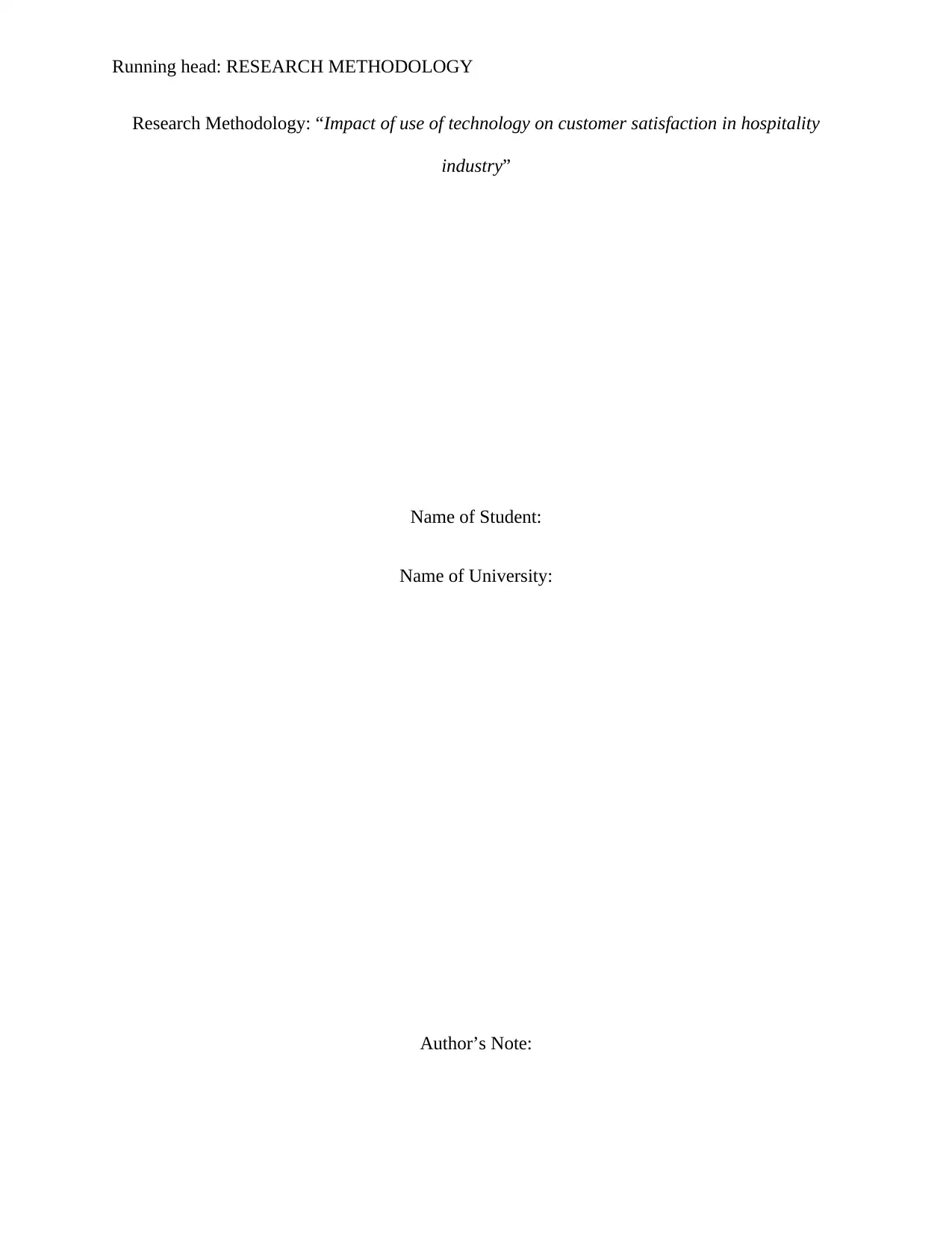
Running head: RESEARCH METHODOLOGY
Research Methodology: “Impact of use of technology on customer satisfaction in hospitality
industry”
Name of Student:
Name of University:
Author’s Note:
Research Methodology: “Impact of use of technology on customer satisfaction in hospitality
industry”
Name of Student:
Name of University:
Author’s Note:
Paraphrase This Document
Need a fresh take? Get an instant paraphrase of this document with our AI Paraphraser
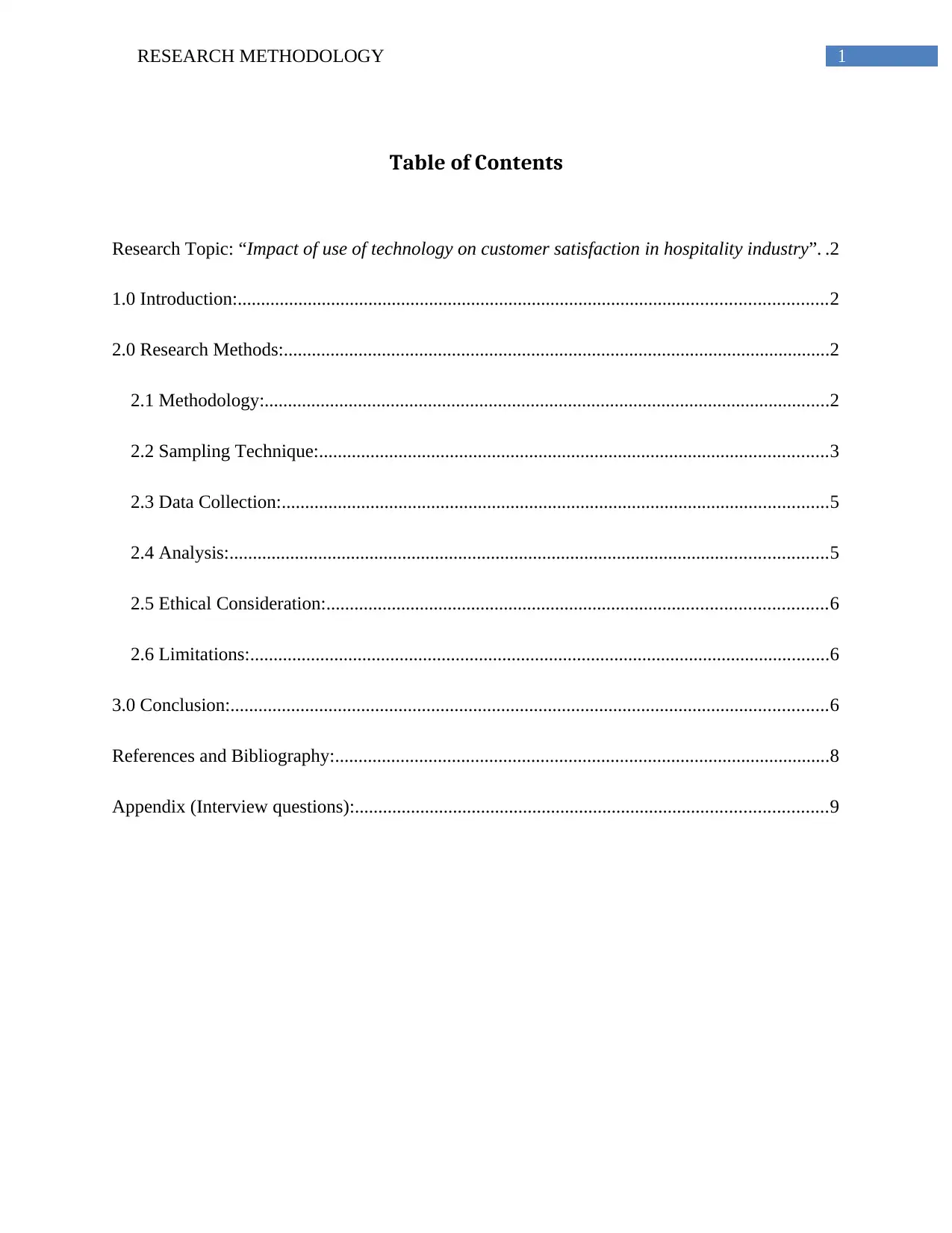
1RESEARCH METHODOLOGY
Table of Contents
Research Topic: “Impact of use of technology on customer satisfaction in hospitality industry”. .2
1.0 Introduction:..............................................................................................................................2
2.0 Research Methods:.....................................................................................................................2
2.1 Methodology:.........................................................................................................................2
2.2 Sampling Technique:.............................................................................................................3
2.3 Data Collection:.....................................................................................................................5
2.4 Analysis:................................................................................................................................5
2.5 Ethical Consideration:...........................................................................................................6
2.6 Limitations:............................................................................................................................6
3.0 Conclusion:................................................................................................................................6
References and Bibliography:..........................................................................................................8
Appendix (Interview questions):.....................................................................................................9
Table of Contents
Research Topic: “Impact of use of technology on customer satisfaction in hospitality industry”. .2
1.0 Introduction:..............................................................................................................................2
2.0 Research Methods:.....................................................................................................................2
2.1 Methodology:.........................................................................................................................2
2.2 Sampling Technique:.............................................................................................................3
2.3 Data Collection:.....................................................................................................................5
2.4 Analysis:................................................................................................................................5
2.5 Ethical Consideration:...........................................................................................................6
2.6 Limitations:............................................................................................................................6
3.0 Conclusion:................................................................................................................................6
References and Bibliography:..........................................................................................................8
Appendix (Interview questions):.....................................................................................................9
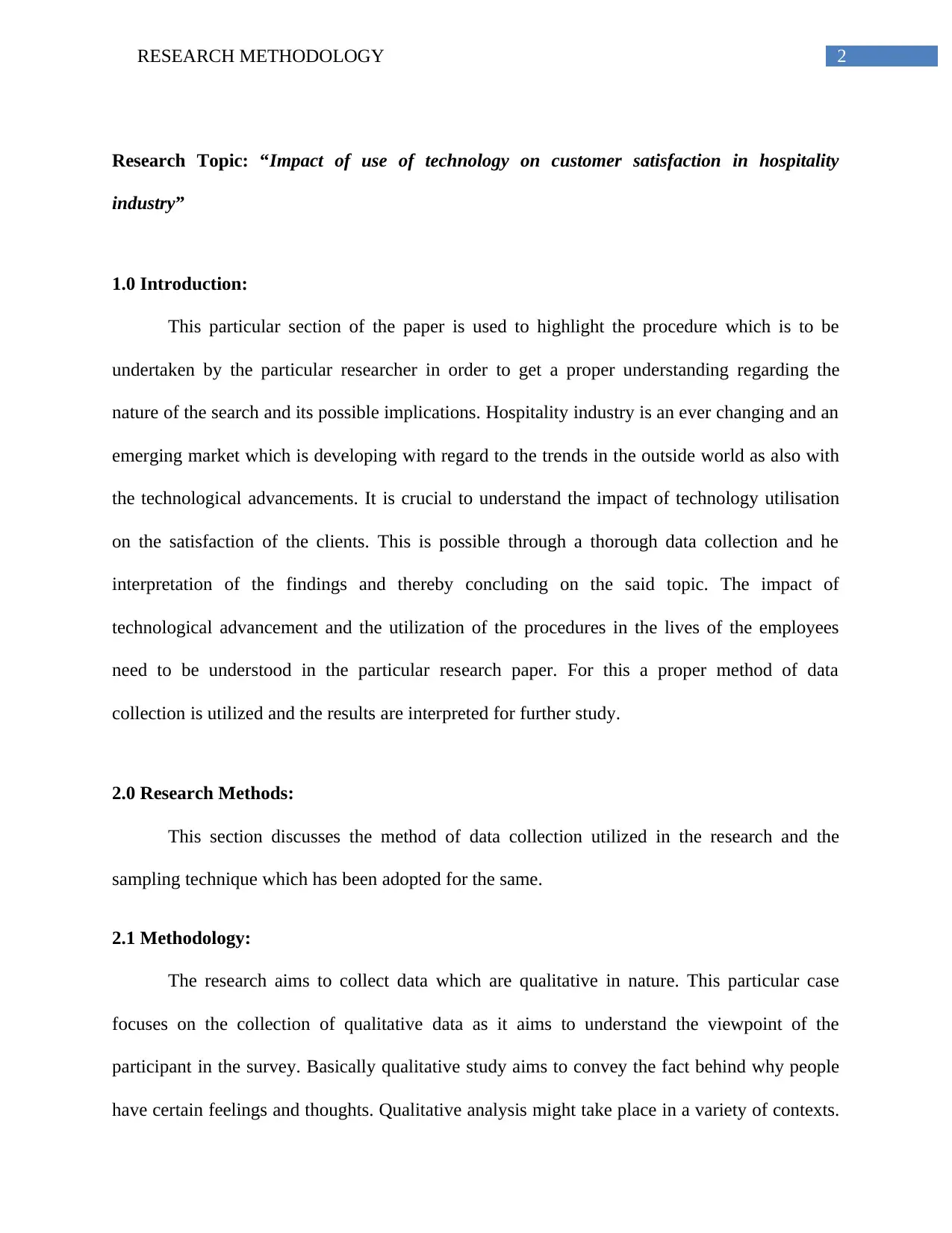
2RESEARCH METHODOLOGY
Research Topic: “Impact of use of technology on customer satisfaction in hospitality
industry”
1.0 Introduction:
This particular section of the paper is used to highlight the procedure which is to be
undertaken by the particular researcher in order to get a proper understanding regarding the
nature of the search and its possible implications. Hospitality industry is an ever changing and an
emerging market which is developing with regard to the trends in the outside world as also with
the technological advancements. It is crucial to understand the impact of technology utilisation
on the satisfaction of the clients. This is possible through a thorough data collection and he
interpretation of the findings and thereby concluding on the said topic. The impact of
technological advancement and the utilization of the procedures in the lives of the employees
need to be understood in the particular research paper. For this a proper method of data
collection is utilized and the results are interpreted for further study.
2.0 Research Methods:
This section discusses the method of data collection utilized in the research and the
sampling technique which has been adopted for the same.
2.1 Methodology:
The research aims to collect data which are qualitative in nature. This particular case
focuses on the collection of qualitative data as it aims to understand the viewpoint of the
participant in the survey. Basically qualitative study aims to convey the fact behind why people
have certain feelings and thoughts. Qualitative analysis might take place in a variety of contexts.
Research Topic: “Impact of use of technology on customer satisfaction in hospitality
industry”
1.0 Introduction:
This particular section of the paper is used to highlight the procedure which is to be
undertaken by the particular researcher in order to get a proper understanding regarding the
nature of the search and its possible implications. Hospitality industry is an ever changing and an
emerging market which is developing with regard to the trends in the outside world as also with
the technological advancements. It is crucial to understand the impact of technology utilisation
on the satisfaction of the clients. This is possible through a thorough data collection and he
interpretation of the findings and thereby concluding on the said topic. The impact of
technological advancement and the utilization of the procedures in the lives of the employees
need to be understood in the particular research paper. For this a proper method of data
collection is utilized and the results are interpreted for further study.
2.0 Research Methods:
This section discusses the method of data collection utilized in the research and the
sampling technique which has been adopted for the same.
2.1 Methodology:
The research aims to collect data which are qualitative in nature. This particular case
focuses on the collection of qualitative data as it aims to understand the viewpoint of the
participant in the survey. Basically qualitative study aims to convey the fact behind why people
have certain feelings and thoughts. Qualitative analysis might take place in a variety of contexts.
⊘ This is a preview!⊘
Do you want full access?
Subscribe today to unlock all pages.

Trusted by 1+ million students worldwide
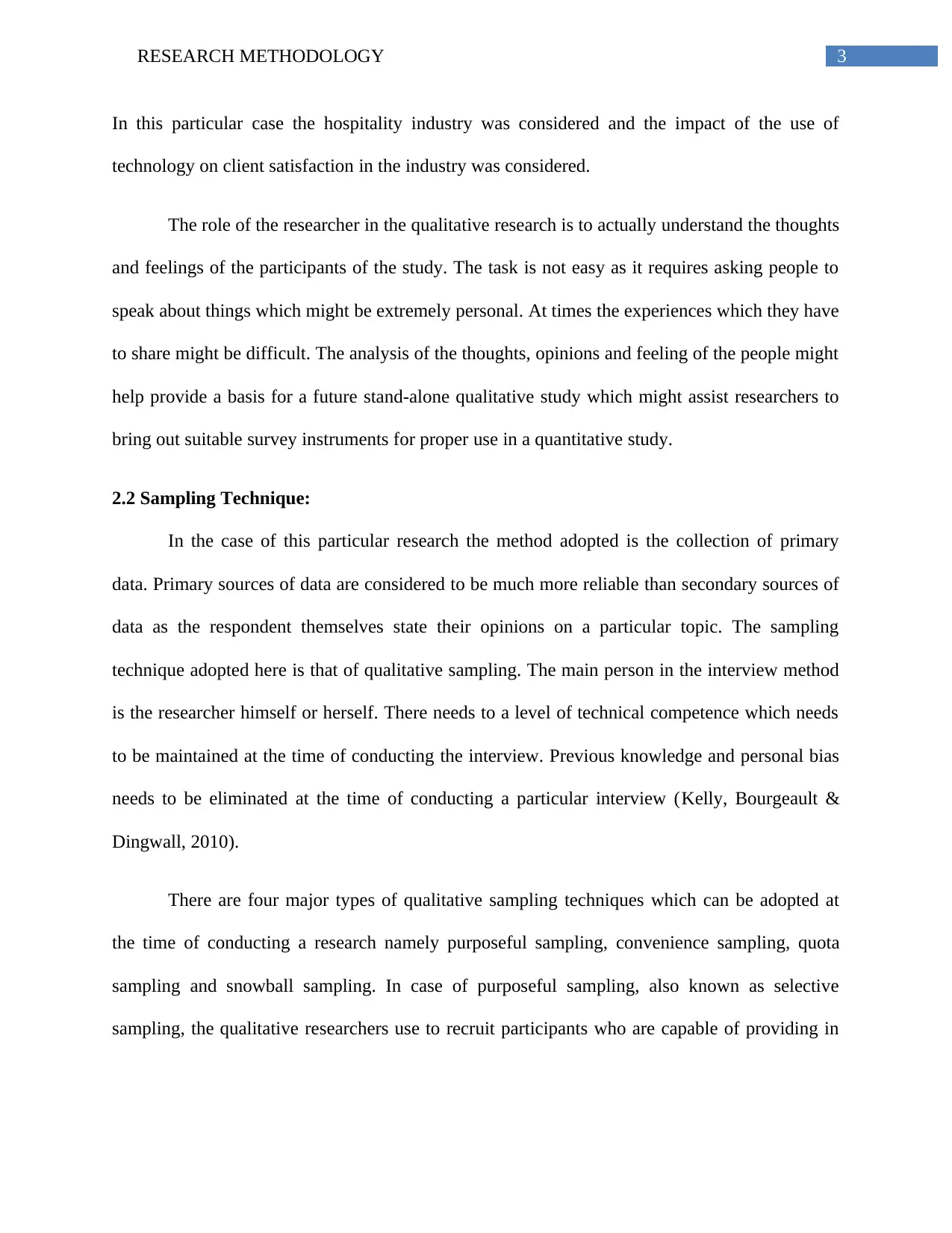
3RESEARCH METHODOLOGY
In this particular case the hospitality industry was considered and the impact of the use of
technology on client satisfaction in the industry was considered.
The role of the researcher in the qualitative research is to actually understand the thoughts
and feelings of the participants of the study. The task is not easy as it requires asking people to
speak about things which might be extremely personal. At times the experiences which they have
to share might be difficult. The analysis of the thoughts, opinions and feeling of the people might
help provide a basis for a future stand-alone qualitative study which might assist researchers to
bring out suitable survey instruments for proper use in a quantitative study.
2.2 Sampling Technique:
In the case of this particular research the method adopted is the collection of primary
data. Primary sources of data are considered to be much more reliable than secondary sources of
data as the respondent themselves state their opinions on a particular topic. The sampling
technique adopted here is that of qualitative sampling. The main person in the interview method
is the researcher himself or herself. There needs to a level of technical competence which needs
to be maintained at the time of conducting the interview. Previous knowledge and personal bias
needs to be eliminated at the time of conducting a particular interview (Kelly, Bourgeault &
Dingwall, 2010).
There are four major types of qualitative sampling techniques which can be adopted at
the time of conducting a research namely purposeful sampling, convenience sampling, quota
sampling and snowball sampling. In case of purposeful sampling, also known as selective
sampling, the qualitative researchers use to recruit participants who are capable of providing in
In this particular case the hospitality industry was considered and the impact of the use of
technology on client satisfaction in the industry was considered.
The role of the researcher in the qualitative research is to actually understand the thoughts
and feelings of the participants of the study. The task is not easy as it requires asking people to
speak about things which might be extremely personal. At times the experiences which they have
to share might be difficult. The analysis of the thoughts, opinions and feeling of the people might
help provide a basis for a future stand-alone qualitative study which might assist researchers to
bring out suitable survey instruments for proper use in a quantitative study.
2.2 Sampling Technique:
In the case of this particular research the method adopted is the collection of primary
data. Primary sources of data are considered to be much more reliable than secondary sources of
data as the respondent themselves state their opinions on a particular topic. The sampling
technique adopted here is that of qualitative sampling. The main person in the interview method
is the researcher himself or herself. There needs to a level of technical competence which needs
to be maintained at the time of conducting the interview. Previous knowledge and personal bias
needs to be eliminated at the time of conducting a particular interview (Kelly, Bourgeault &
Dingwall, 2010).
There are four major types of qualitative sampling techniques which can be adopted at
the time of conducting a research namely purposeful sampling, convenience sampling, quota
sampling and snowball sampling. In case of purposeful sampling, also known as selective
sampling, the qualitative researchers use to recruit participants who are capable of providing in
Paraphrase This Document
Need a fresh take? Get an instant paraphrase of this document with our AI Paraphraser
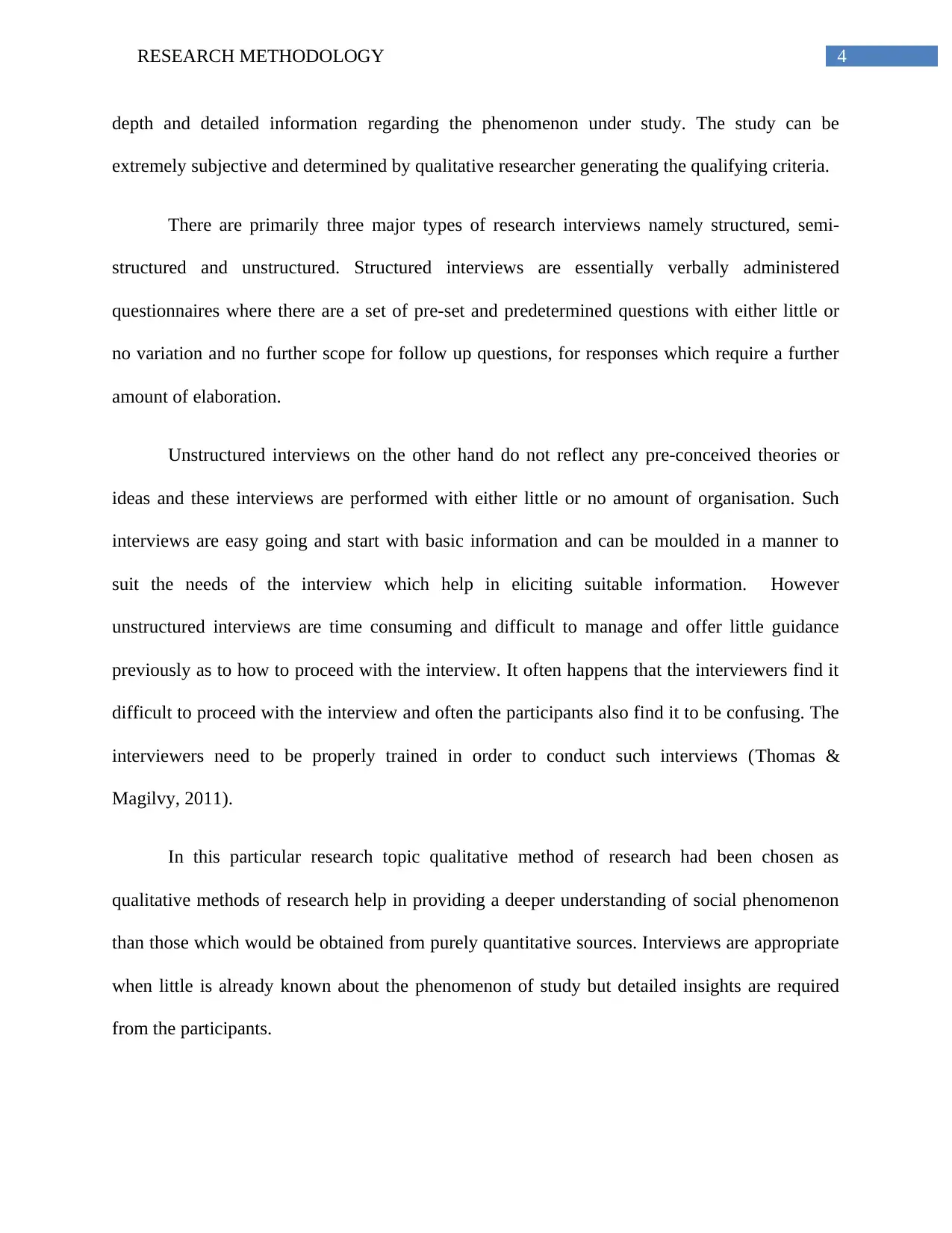
4RESEARCH METHODOLOGY
depth and detailed information regarding the phenomenon under study. The study can be
extremely subjective and determined by qualitative researcher generating the qualifying criteria.
There are primarily three major types of research interviews namely structured, semi-
structured and unstructured. Structured interviews are essentially verbally administered
questionnaires where there are a set of pre-set and predetermined questions with either little or
no variation and no further scope for follow up questions, for responses which require a further
amount of elaboration.
Unstructured interviews on the other hand do not reflect any pre-conceived theories or
ideas and these interviews are performed with either little or no amount of organisation. Such
interviews are easy going and start with basic information and can be moulded in a manner to
suit the needs of the interview which help in eliciting suitable information. However
unstructured interviews are time consuming and difficult to manage and offer little guidance
previously as to how to proceed with the interview. It often happens that the interviewers find it
difficult to proceed with the interview and often the participants also find it to be confusing. The
interviewers need to be properly trained in order to conduct such interviews (Thomas &
Magilvy, 2011).
In this particular research topic qualitative method of research had been chosen as
qualitative methods of research help in providing a deeper understanding of social phenomenon
than those which would be obtained from purely quantitative sources. Interviews are appropriate
when little is already known about the phenomenon of study but detailed insights are required
from the participants.
depth and detailed information regarding the phenomenon under study. The study can be
extremely subjective and determined by qualitative researcher generating the qualifying criteria.
There are primarily three major types of research interviews namely structured, semi-
structured and unstructured. Structured interviews are essentially verbally administered
questionnaires where there are a set of pre-set and predetermined questions with either little or
no variation and no further scope for follow up questions, for responses which require a further
amount of elaboration.
Unstructured interviews on the other hand do not reflect any pre-conceived theories or
ideas and these interviews are performed with either little or no amount of organisation. Such
interviews are easy going and start with basic information and can be moulded in a manner to
suit the needs of the interview which help in eliciting suitable information. However
unstructured interviews are time consuming and difficult to manage and offer little guidance
previously as to how to proceed with the interview. It often happens that the interviewers find it
difficult to proceed with the interview and often the participants also find it to be confusing. The
interviewers need to be properly trained in order to conduct such interviews (Thomas &
Magilvy, 2011).
In this particular research topic qualitative method of research had been chosen as
qualitative methods of research help in providing a deeper understanding of social phenomenon
than those which would be obtained from purely quantitative sources. Interviews are appropriate
when little is already known about the phenomenon of study but detailed insights are required
from the participants.
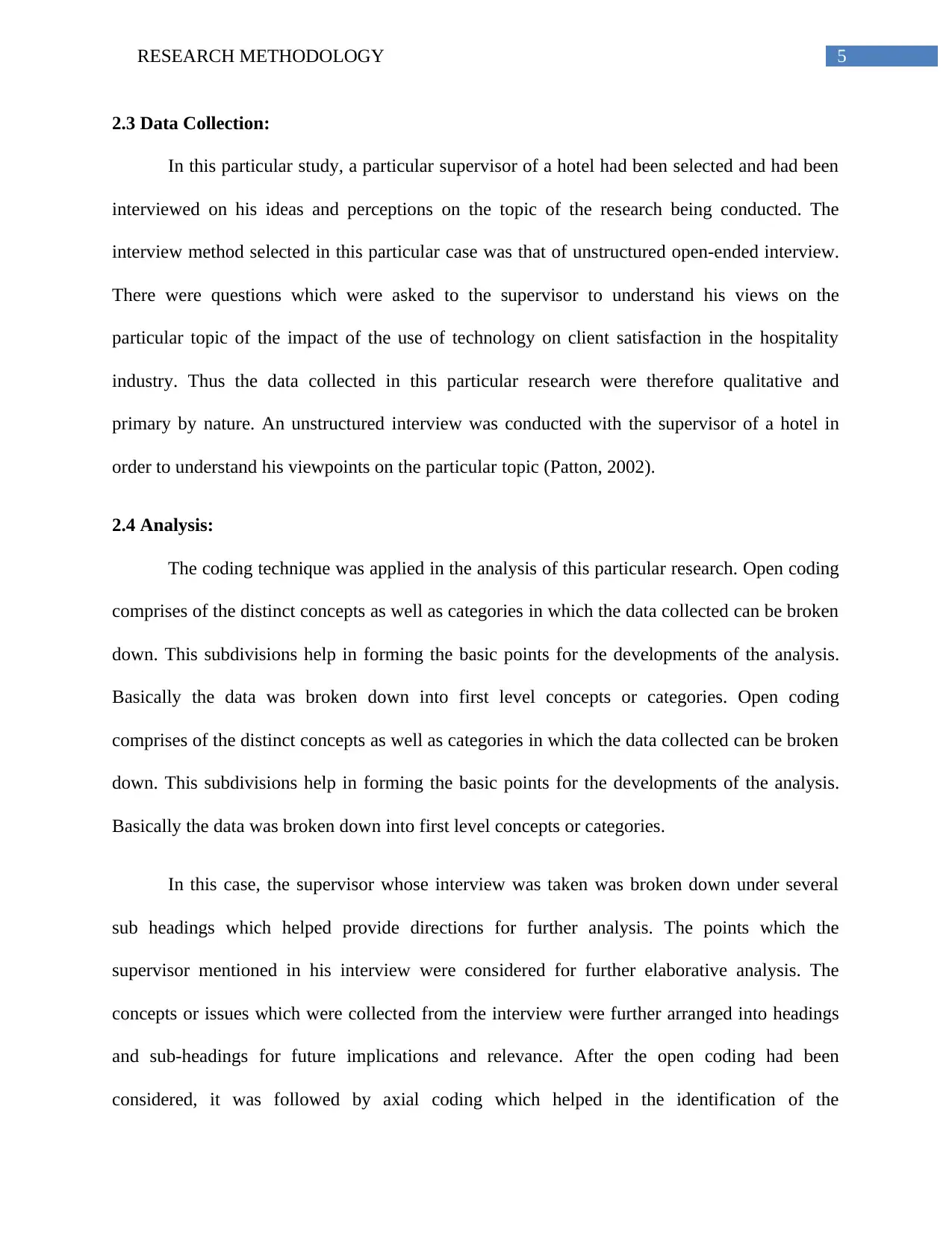
5RESEARCH METHODOLOGY
2.3 Data Collection:
In this particular study, a particular supervisor of a hotel had been selected and had been
interviewed on his ideas and perceptions on the topic of the research being conducted. The
interview method selected in this particular case was that of unstructured open-ended interview.
There were questions which were asked to the supervisor to understand his views on the
particular topic of the impact of the use of technology on client satisfaction in the hospitality
industry. Thus the data collected in this particular research were therefore qualitative and
primary by nature. An unstructured interview was conducted with the supervisor of a hotel in
order to understand his viewpoints on the particular topic (Patton, 2002).
2.4 Analysis:
The coding technique was applied in the analysis of this particular research. Open coding
comprises of the distinct concepts as well as categories in which the data collected can be broken
down. This subdivisions help in forming the basic points for the developments of the analysis.
Basically the data was broken down into first level concepts or categories. Open coding
comprises of the distinct concepts as well as categories in which the data collected can be broken
down. This subdivisions help in forming the basic points for the developments of the analysis.
Basically the data was broken down into first level concepts or categories.
In this case, the supervisor whose interview was taken was broken down under several
sub headings which helped provide directions for further analysis. The points which the
supervisor mentioned in his interview were considered for further elaborative analysis. The
concepts or issues which were collected from the interview were further arranged into headings
and sub-headings for future implications and relevance. After the open coding had been
considered, it was followed by axial coding which helped in the identification of the
2.3 Data Collection:
In this particular study, a particular supervisor of a hotel had been selected and had been
interviewed on his ideas and perceptions on the topic of the research being conducted. The
interview method selected in this particular case was that of unstructured open-ended interview.
There were questions which were asked to the supervisor to understand his views on the
particular topic of the impact of the use of technology on client satisfaction in the hospitality
industry. Thus the data collected in this particular research were therefore qualitative and
primary by nature. An unstructured interview was conducted with the supervisor of a hotel in
order to understand his viewpoints on the particular topic (Patton, 2002).
2.4 Analysis:
The coding technique was applied in the analysis of this particular research. Open coding
comprises of the distinct concepts as well as categories in which the data collected can be broken
down. This subdivisions help in forming the basic points for the developments of the analysis.
Basically the data was broken down into first level concepts or categories. Open coding
comprises of the distinct concepts as well as categories in which the data collected can be broken
down. This subdivisions help in forming the basic points for the developments of the analysis.
Basically the data was broken down into first level concepts or categories.
In this case, the supervisor whose interview was taken was broken down under several
sub headings which helped provide directions for further analysis. The points which the
supervisor mentioned in his interview were considered for further elaborative analysis. The
concepts or issues which were collected from the interview were further arranged into headings
and sub-headings for future implications and relevance. After the open coding had been
considered, it was followed by axial coding which helped in the identification of the
⊘ This is a preview!⊘
Do you want full access?
Subscribe today to unlock all pages.

Trusted by 1+ million students worldwide
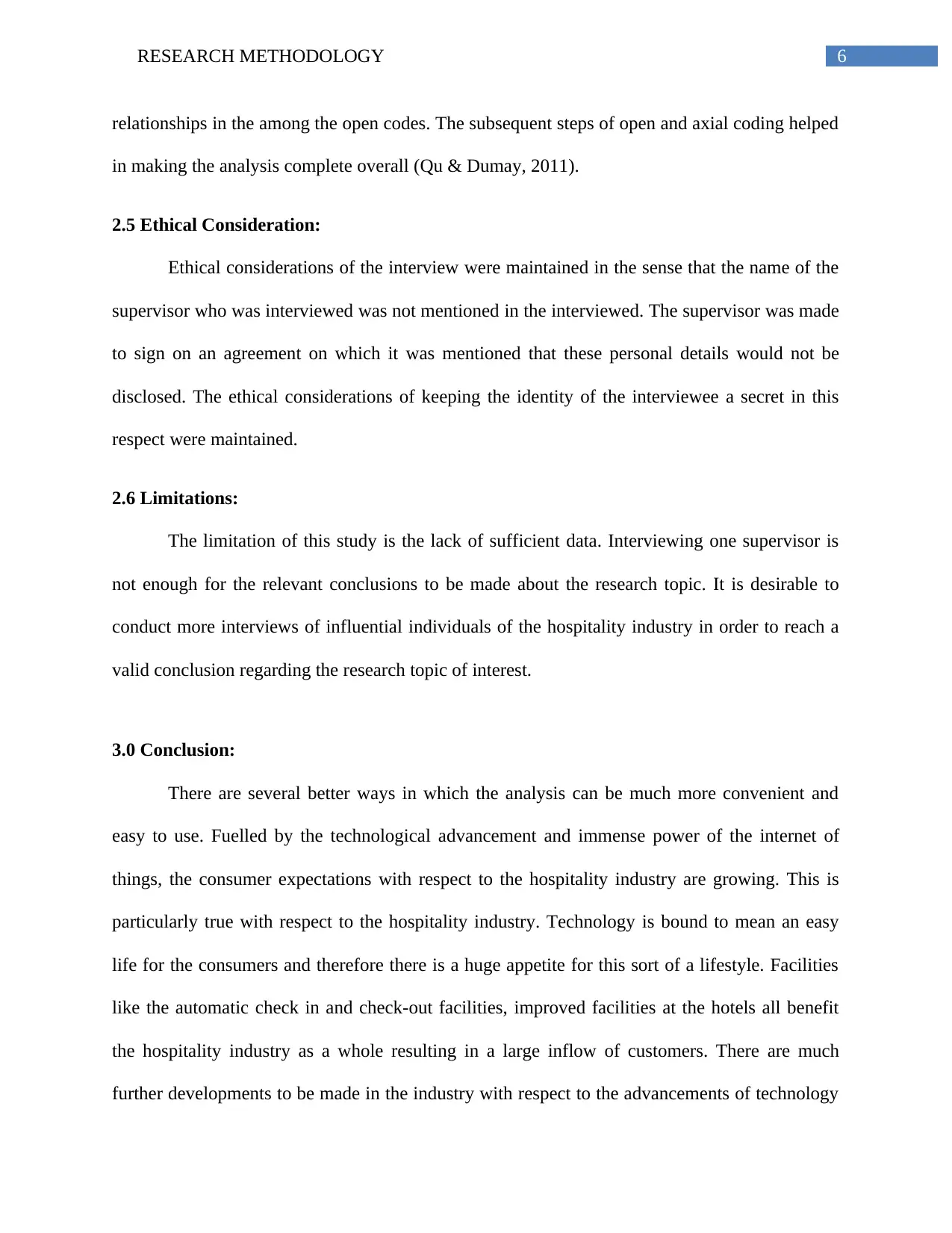
6RESEARCH METHODOLOGY
relationships in the among the open codes. The subsequent steps of open and axial coding helped
in making the analysis complete overall (Qu & Dumay, 2011).
2.5 Ethical Consideration:
Ethical considerations of the interview were maintained in the sense that the name of the
supervisor who was interviewed was not mentioned in the interviewed. The supervisor was made
to sign on an agreement on which it was mentioned that these personal details would not be
disclosed. The ethical considerations of keeping the identity of the interviewee a secret in this
respect were maintained.
2.6 Limitations:
The limitation of this study is the lack of sufficient data. Interviewing one supervisor is
not enough for the relevant conclusions to be made about the research topic. It is desirable to
conduct more interviews of influential individuals of the hospitality industry in order to reach a
valid conclusion regarding the research topic of interest.
3.0 Conclusion:
There are several better ways in which the analysis can be much more convenient and
easy to use. Fuelled by the technological advancement and immense power of the internet of
things, the consumer expectations with respect to the hospitality industry are growing. This is
particularly true with respect to the hospitality industry. Technology is bound to mean an easy
life for the consumers and therefore there is a huge appetite for this sort of a lifestyle. Facilities
like the automatic check in and check-out facilities, improved facilities at the hotels all benefit
the hospitality industry as a whole resulting in a large inflow of customers. There are much
further developments to be made in the industry with respect to the advancements of technology
relationships in the among the open codes. The subsequent steps of open and axial coding helped
in making the analysis complete overall (Qu & Dumay, 2011).
2.5 Ethical Consideration:
Ethical considerations of the interview were maintained in the sense that the name of the
supervisor who was interviewed was not mentioned in the interviewed. The supervisor was made
to sign on an agreement on which it was mentioned that these personal details would not be
disclosed. The ethical considerations of keeping the identity of the interviewee a secret in this
respect were maintained.
2.6 Limitations:
The limitation of this study is the lack of sufficient data. Interviewing one supervisor is
not enough for the relevant conclusions to be made about the research topic. It is desirable to
conduct more interviews of influential individuals of the hospitality industry in order to reach a
valid conclusion regarding the research topic of interest.
3.0 Conclusion:
There are several better ways in which the analysis can be much more convenient and
easy to use. Fuelled by the technological advancement and immense power of the internet of
things, the consumer expectations with respect to the hospitality industry are growing. This is
particularly true with respect to the hospitality industry. Technology is bound to mean an easy
life for the consumers and therefore there is a huge appetite for this sort of a lifestyle. Facilities
like the automatic check in and check-out facilities, improved facilities at the hotels all benefit
the hospitality industry as a whole resulting in a large inflow of customers. There are much
further developments to be made in the industry with respect to the advancements of technology
Paraphrase This Document
Need a fresh take? Get an instant paraphrase of this document with our AI Paraphraser
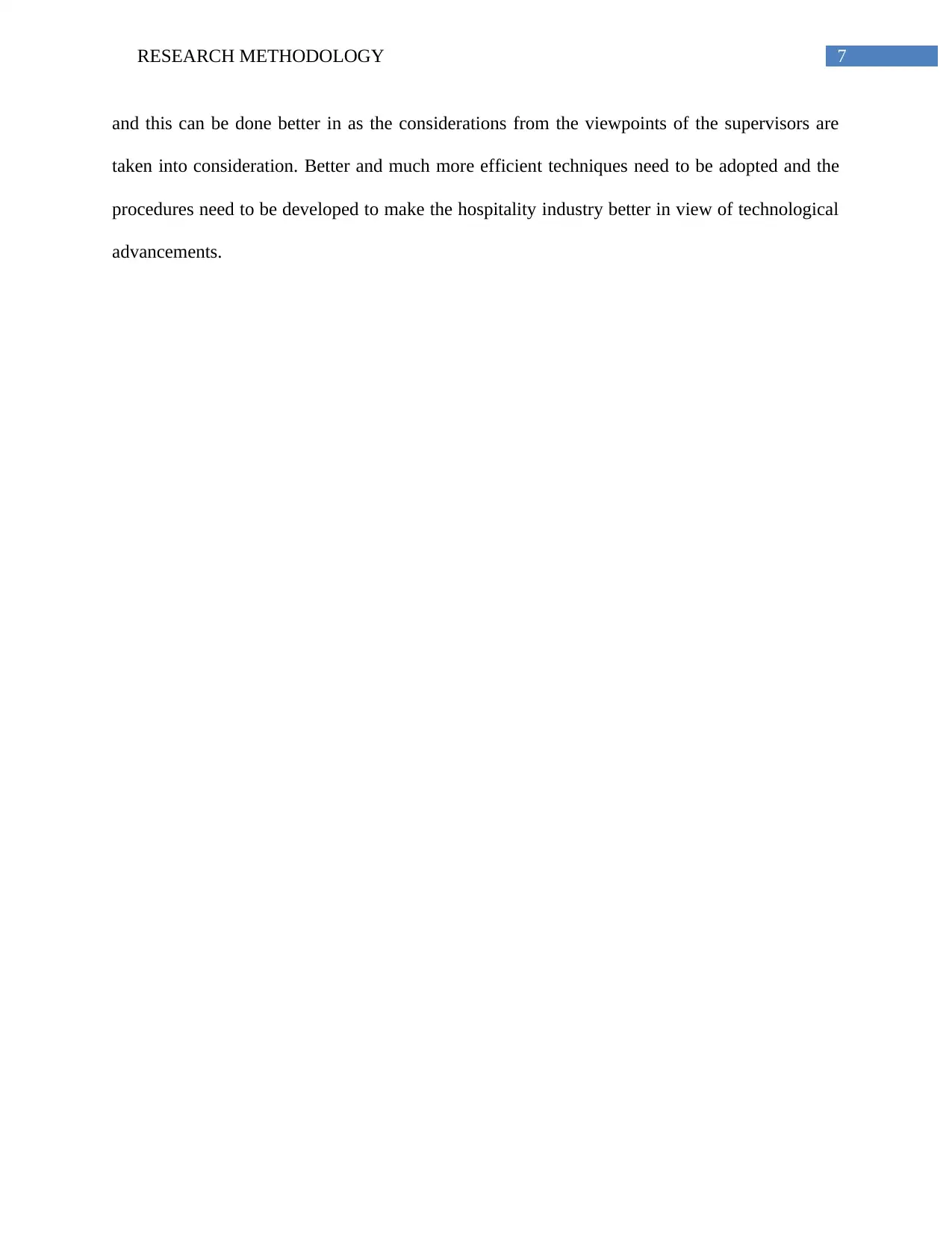
7RESEARCH METHODOLOGY
and this can be done better in as the considerations from the viewpoints of the supervisors are
taken into consideration. Better and much more efficient techniques need to be adopted and the
procedures need to be developed to make the hospitality industry better in view of technological
advancements.
and this can be done better in as the considerations from the viewpoints of the supervisors are
taken into consideration. Better and much more efficient techniques need to be adopted and the
procedures need to be developed to make the hospitality industry better in view of technological
advancements.
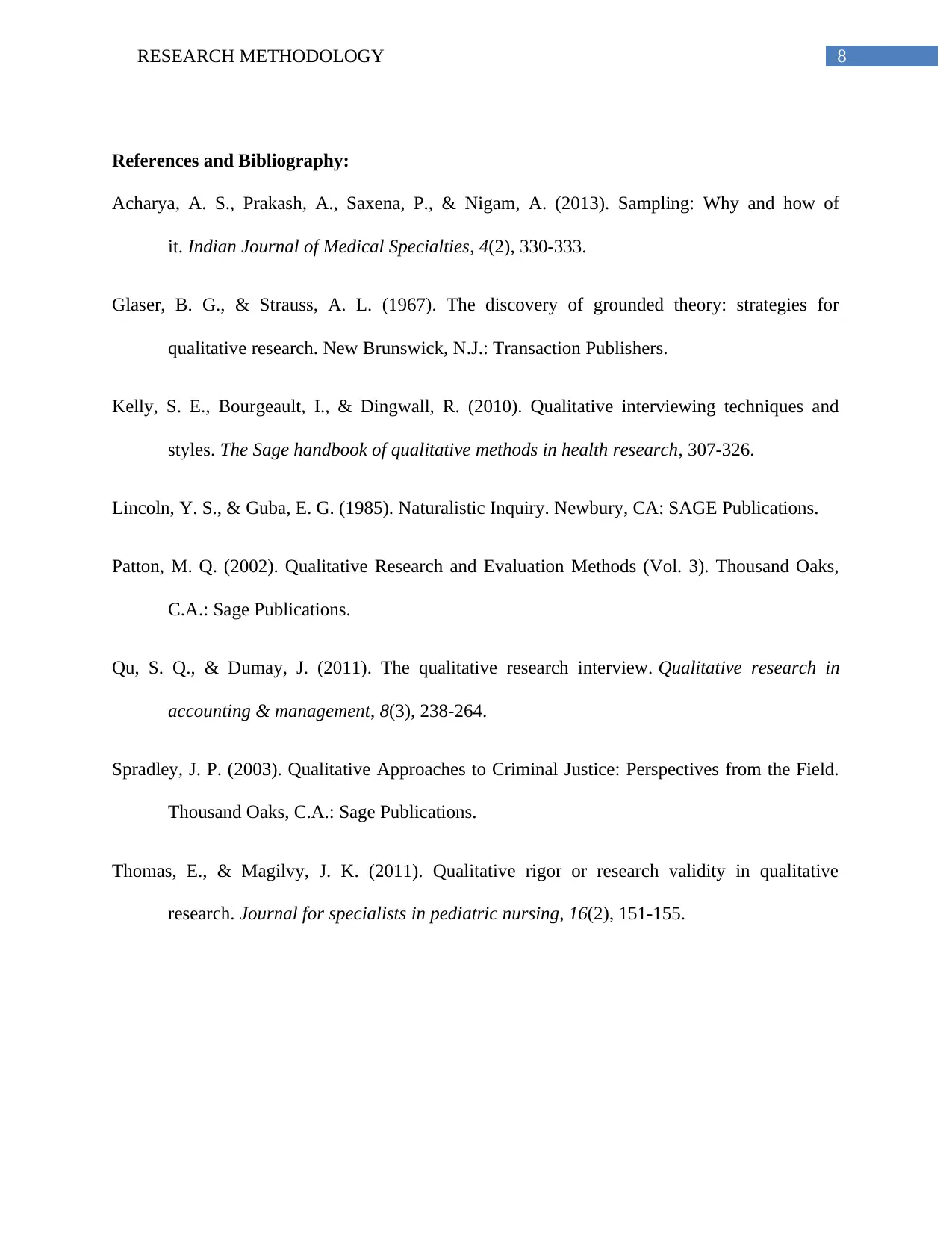
8RESEARCH METHODOLOGY
References and Bibliography:
Acharya, A. S., Prakash, A., Saxena, P., & Nigam, A. (2013). Sampling: Why and how of
it. Indian Journal of Medical Specialties, 4(2), 330-333.
Glaser, B. G., & Strauss, A. L. (1967). The discovery of grounded theory: strategies for
qualitative research. New Brunswick, N.J.: Transaction Publishers.
Kelly, S. E., Bourgeault, I., & Dingwall, R. (2010). Qualitative interviewing techniques and
styles. The Sage handbook of qualitative methods in health research, 307-326.
Lincoln, Y. S., & Guba, E. G. (1985). Naturalistic Inquiry. Newbury, CA: SAGE Publications.
Patton, M. Q. (2002). Qualitative Research and Evaluation Methods (Vol. 3). Thousand Oaks,
C.A.: Sage Publications.
Qu, S. Q., & Dumay, J. (2011). The qualitative research interview. Qualitative research in
accounting & management, 8(3), 238-264.
Spradley, J. P. (2003). Qualitative Approaches to Criminal Justice: Perspectives from the Field.
Thousand Oaks, C.A.: Sage Publications.
Thomas, E., & Magilvy, J. K. (2011). Qualitative rigor or research validity in qualitative
research. Journal for specialists in pediatric nursing, 16(2), 151-155.
References and Bibliography:
Acharya, A. S., Prakash, A., Saxena, P., & Nigam, A. (2013). Sampling: Why and how of
it. Indian Journal of Medical Specialties, 4(2), 330-333.
Glaser, B. G., & Strauss, A. L. (1967). The discovery of grounded theory: strategies for
qualitative research. New Brunswick, N.J.: Transaction Publishers.
Kelly, S. E., Bourgeault, I., & Dingwall, R. (2010). Qualitative interviewing techniques and
styles. The Sage handbook of qualitative methods in health research, 307-326.
Lincoln, Y. S., & Guba, E. G. (1985). Naturalistic Inquiry. Newbury, CA: SAGE Publications.
Patton, M. Q. (2002). Qualitative Research and Evaluation Methods (Vol. 3). Thousand Oaks,
C.A.: Sage Publications.
Qu, S. Q., & Dumay, J. (2011). The qualitative research interview. Qualitative research in
accounting & management, 8(3), 238-264.
Spradley, J. P. (2003). Qualitative Approaches to Criminal Justice: Perspectives from the Field.
Thousand Oaks, C.A.: Sage Publications.
Thomas, E., & Magilvy, J. K. (2011). Qualitative rigor or research validity in qualitative
research. Journal for specialists in pediatric nursing, 16(2), 151-155.
⊘ This is a preview!⊘
Do you want full access?
Subscribe today to unlock all pages.

Trusted by 1+ million students worldwide
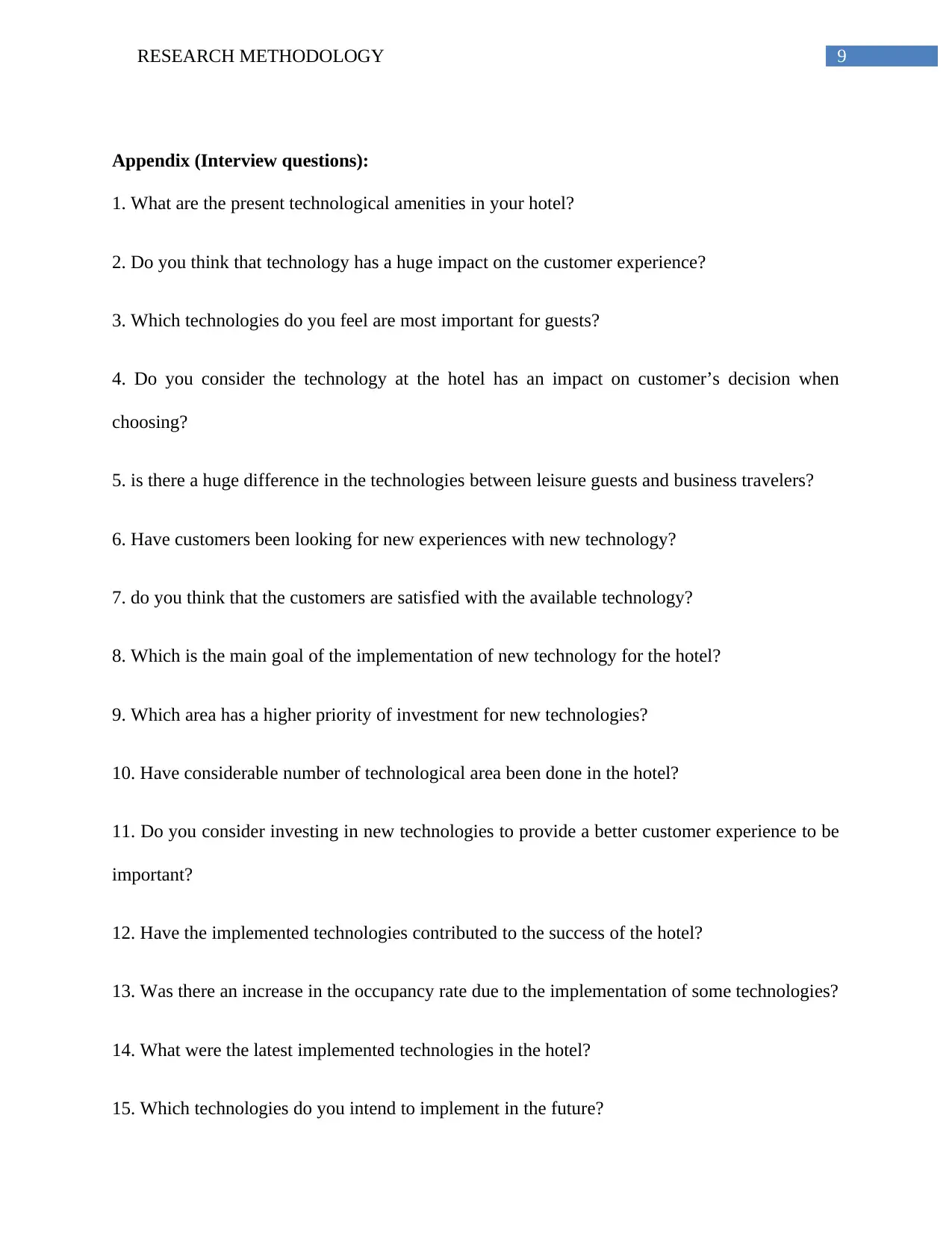
9RESEARCH METHODOLOGY
Appendix (Interview questions):
1. What are the present technological amenities in your hotel?
2. Do you think that technology has a huge impact on the customer experience?
3. Which technologies do you feel are most important for guests?
4. Do you consider the technology at the hotel has an impact on customer’s decision when
choosing?
5. is there a huge difference in the technologies between leisure guests and business travelers?
6. Have customers been looking for new experiences with new technology?
7. do you think that the customers are satisfied with the available technology?
8. Which is the main goal of the implementation of new technology for the hotel?
9. Which area has a higher priority of investment for new technologies?
10. Have considerable number of technological area been done in the hotel?
11. Do you consider investing in new technologies to provide a better customer experience to be
important?
12. Have the implemented technologies contributed to the success of the hotel?
13. Was there an increase in the occupancy rate due to the implementation of some technologies?
14. What were the latest implemented technologies in the hotel?
15. Which technologies do you intend to implement in the future?
Appendix (Interview questions):
1. What are the present technological amenities in your hotel?
2. Do you think that technology has a huge impact on the customer experience?
3. Which technologies do you feel are most important for guests?
4. Do you consider the technology at the hotel has an impact on customer’s decision when
choosing?
5. is there a huge difference in the technologies between leisure guests and business travelers?
6. Have customers been looking for new experiences with new technology?
7. do you think that the customers are satisfied with the available technology?
8. Which is the main goal of the implementation of new technology for the hotel?
9. Which area has a higher priority of investment for new technologies?
10. Have considerable number of technological area been done in the hotel?
11. Do you consider investing in new technologies to provide a better customer experience to be
important?
12. Have the implemented technologies contributed to the success of the hotel?
13. Was there an increase in the occupancy rate due to the implementation of some technologies?
14. What were the latest implemented technologies in the hotel?
15. Which technologies do you intend to implement in the future?
1 out of 10
Related Documents
Your All-in-One AI-Powered Toolkit for Academic Success.
+13062052269
info@desklib.com
Available 24*7 on WhatsApp / Email
![[object Object]](/_next/static/media/star-bottom.7253800d.svg)
Unlock your academic potential
Copyright © 2020–2025 A2Z Services. All Rights Reserved. Developed and managed by ZUCOL.





